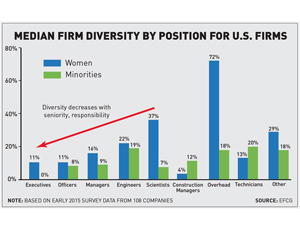Meeting diversity goals for employee numbers and pay continues to daunt engineering and construction firms, but their human-resource managers say they face their own challenges in gaining more visibility and influence in company C-suites.
In its latest survey of HR trends in design, design-build and program management firms, financial management consultant EFCG found that the median proportion of women in company ranks is 26.7% and 14.7% for minorities. Minorities fared the best in megafirms over $1 billion in revenue, making up 22.6% of staff, and worst in firms of $100 million or less, comprising just 8.9%.
EFCG survey manager Joe Smetona noted little change in the results over the past six years.
Data is based on responses from HR managers from 108 firms, including some based outside the U.S., that represent 831,000 employees and $222 billion in 2014 gross revenue. EFCG's analysis, presented to about 90 HR managers in New York City on May 14, also included data showing gender-based compensation gaps as employees progressed up the ranks.
While entry-level engineer pay is about equal, a 10.7% gap emerges for those in the highest chief-engineer position. Among non-executive managers who do not report directly to CEOs in billion-dollar-plus companies, the male-female pay gap is 21.4%, says the survey.
Smetona points to other barriers in recruiting and retaining women, including "poor maternity benefits, cultural challenges and resistance to change."
Kevin Brown, HR vice president at Atkins North America, noted added scrutiny of compensation by the federal government of firms that are U.S. contractors. Under new rules now in effect or being drafted, "there's an aggressivenss I've not seen before," he said.
Brian Kundert, HR senior vice president at ARCADIS, said firm growth is what provides added "bandwidth" to boost diversity. He added that the tendency to hire people based on technical excellence or specialized skills often doesnt include whether they are "motivated to run a little piece of the business."
But Smetona says the challenge is greatest for both sexes at the midcareer level, with more firms now extending eligibility for long-term compensation "beyond the executive suite to officers and other key employees."
Pelly Shafto, HR vice president at engineer Morrison Hershfield, said, "Clients are looking for intermediate-level engineers. We have to invest in them."
Michelle White, HR manager at ICF International, noted the risk of "stress and burnout" among mid-level managers in "multi-tasking environments," and said the firm is pushing new efforts to better connect those employees to limit turnover, particularly among project managers.
HR managers at the EFCG event noted the impact of technology on recruiting and the need for better applicant-tracking systems among their younger hires. "Millennials have to be able to do their applications on cell phones," said Mark Gundacker, HR vice president for designer Cardno Americas.
Managers also noted new efforts to time incentives more closely to performance, with more frequent monetary rewards. Mary Horan, senior vice president at Merrick, noted that under the firm's incentive program, awards are posted monthly on the firm's Linked in page.
AECOM's new incentives program, called "Deliver to Win," allows Americas-based participants on projects larger than $500,000 that exceed delivery goals to share in profit rewards, says Ian MacLeod, regional HR senior vice president. He said about 40% of its Americas-based PMs are eligible for the benefit to apply to about 2,000 projects.
EFCG survey data also indicate that HR cost comprises just 1.2% of median firm net revenue, which Smetona said is the lowest of corporate overhead functions. Future analysis will look at how firms account for costs of training and HR-related time of billable managers.
Tony Bollinger, partner at recruiter CareerSmith, noted firms' tendency to "pick on" HR budgets when money gets tight, but he said as workforce management demonsrates a return on investment, CFOs "are starting to get it."








Post a comment to this article
Report Abusive Comment